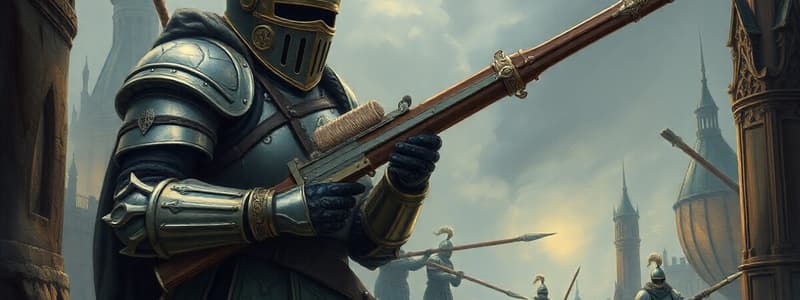Podcast
Questions and Answers
The counterweight was a significant siege weapon used for hurling stones very far distances during the Middle Ages.
The counterweight was a significant siege weapon used for hurling stones very far distances during the Middle Ages.
True (A)
The longbow was primarily used by the French during the Hundred Years' War.
The longbow was primarily used by the French during the Hundred Years' War.
False (B)
A blast furnace for cast iron first appeared in Northern Europe around 1150.
A blast furnace for cast iron first appeared in Northern Europe around 1150.
False (B)
Vertical windmills were used primarily for draining water and grinding grain.
Vertical windmills were used primarily for draining water and grinding grain.
Spectacles with convex lenses were first developed to assist people who were near-sighted.
Spectacles with convex lenses were first developed to assist people who were near-sighted.
The earliest form of chess is said to have originated from India.
The earliest form of chess is said to have originated from India.
Oil paint was introduced in the 13th century by the painter Jan Van Eyck.
Oil paint was introduced in the 13th century by the painter Jan Van Eyck.
Artesian wells derive their name from the French region of Artois, where they were first developed.
Artesian wells derive their name from the French region of Artois, where they were first developed.
The hauberk was a type of full plate armor used during the late Middle Ages.
The hauberk was a type of full plate armor used during the late Middle Ages.
Horseshoes were essential for horses to adapt to rocky terrains and for carrying heavier loads.
Horseshoes were essential for horses to adapt to rocky terrains and for carrying heavier loads.
Flashcards are hidden until you start studying
Study Notes
Medieval Advancements
- Counterweight: A revolutionary siege weapon, using counterweights to hurl large stones; first utilized in the Eastern Mediterranean basin
- Longbow: Employed by the English against the French during the Hundred Years' War; powerful, accurate, and contributed to the decline of the medieval knight class
- Steel Crossbow: The first handheld mechanical crossbow, originating in Europe with various cocking aids to enhance draw power
- Full Plate Armour: Appeared in the late 14th century, utilizing thousands of metal rings; considered the best personal armor for protection, showcasing metalworking skills
- Blast Furnace/Cast Iron: First appeared in middle Europe around 1150
- Hourglass: Offered a reliable, affordable, and accurate way to measure time
- Vertical Windmills: Efficient at grinding grain or draining water
- Spectacles: Composed of convex lenses, aiding farsighted individuals
- Chess: While said to have origins in India, its earliest predecessors reached Europe during the Middle Ages
- Mirrors: Alexander Neckham of 1180 described how removing lead behind glass eliminates reflections
- Oil Paint: Invented around 1410 by Flemish painter Jan Van Eyck; introduced a stable oil mixture, crucial for Northern European agriculture
- Horse-Drawn Plough: Used for cultivating heavy, rich soils, enhancing agricultural practices
- Horseshoes: Enabled horses to adapt to diverse terrain and carry heavier loads
- Artesian Wells: First drilled by Carthusian monks in Artois, France in 1126; utilize underground water pressure to bring water to the surface without pumping
- Wheelbarrow: Utilized in construction, mining, and farming to transport materials; first documented in Siena, Italy
Studying That Suits You
Use AI to generate personalized quizzes and flashcards to suit your learning preferences.




